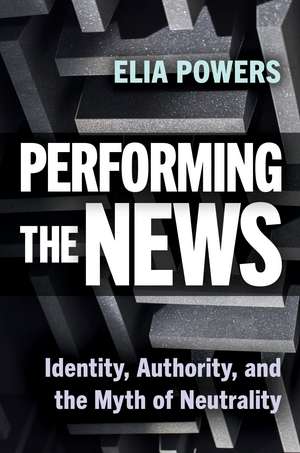Performing the News: Identity, Authority, and the Myth of Neutrality
Autor Elia Powersen Limba Engleză Paperback – 13 sep 2024
Performing the News: Identity, Authority, and the Myth of Neutrality explores how journalists from historically marginalized groups have long felt pressure to conform when performing for audiences. Many speak with a flat, “neutral” accent, modify their delivery to hide distinctive vocal attributes, dress conventionally to appeal to the “average” viewer, and maintain a consistent appearance to avoid unwanted attention. Their aim is what author Elia Powers refers to as performance neutrality—presentation that is deemed unobjectionable, reveals little about journalists’ social identity, and supposedly does not detract from their message. Increasingly, journalists are challenging restrictive, purportedly neutral forms of self-presentation. This book argues that performance neutrality is a myth that reinforces the status quo, limits on-air diversity, and hinders efforts to make newsrooms more inclusive. Through in-depth interviews with journalists in broadcasting and podcasting, and those who shape their performance, the author suggests ways to make journalism more inclusive and representative of diverse audiences.
Preț: 265.51 lei
Nou
Puncte Express: 398
Preț estimativ în valută:
50.81€ • 54.33$ • 42.36£
50.81€ • 54.33$ • 42.36£
Carte disponibilă
Livrare economică 27 martie-10 aprilie
Preluare comenzi: 021 569.72.76
Specificații
ISBN-13: 9781978836679
ISBN-10: 1978836678
Pagini: 228
Ilustrații: no images
Dimensiuni: 156 x 235 x 15 mm
Greutate: 0.32 kg
Editura: Rutgers University Press
Colecția Rutgers University Press
ISBN-10: 1978836678
Pagini: 228
Ilustrații: no images
Dimensiuni: 156 x 235 x 15 mm
Greutate: 0.32 kg
Editura: Rutgers University Press
Colecția Rutgers University Press
Notă biografică
ELIA POWERS is an associate professor of journalism at Towson University, Towson, Maryland. Formerly a news and feature writer, he is now a contributing editor and independent podcast producer/host.
Cuprins
Introduction
Part I Critical Perspectives
1 Covering (on) the News
2 Performance, Form, and the Myth of Neutrality
3 Learning How to Perform
4 The Influential Imagined Audience
Part II Norms and Practices
5 Consistent and Conventional Appearance (Performing on Television – Part I)
6 “Accentless” Speech and Attractive Voices (Performing on Television – Part II)
7 The Enduring #PubRadioVoice (Performing on Radio)
8 Semi-Performative and Vocally Diverse (Performing on Podcasts)
Part III Laws and Suggested Actions
9 Legal Protections and Their Limits
Conclusion: How Change Happens
Acknowledgments
References
Notes
Index
Part I Critical Perspectives
1 Covering (on) the News
2 Performance, Form, and the Myth of Neutrality
3 Learning How to Perform
4 The Influential Imagined Audience
Part II Norms and Practices
5 Consistent and Conventional Appearance (Performing on Television – Part I)
6 “Accentless” Speech and Attractive Voices (Performing on Television – Part II)
7 The Enduring #PubRadioVoice (Performing on Radio)
8 Semi-Performative and Vocally Diverse (Performing on Podcasts)
Part III Laws and Suggested Actions
9 Legal Protections and Their Limits
Conclusion: How Change Happens
Acknowledgments
References
Notes
Index
Recenzii
"Elia Powers has set out to challenge decades of status-quo thinking around one of the thorniest topics in professional communication: How we judge others, and, in turn, how we judge ourselves."
"Dr. Elia M. Powers presents a valuable, thoughtful perspective on journalists navigating identity, authority, and the myth of neutrality. This book should be required reading for anyone interested in the news media."
"Dr. Elia M. Powers presents a valuable, thoughtful perspective on journalists navigating identity, authority, and the myth of neutrality. This book should be required reading for anyone interested in the news media."
Descriere
Performing The News: Identity, Authority, & the Myth of Neutrality explores how journalists from historically marginalized groups have felt pressure to conform when performing for audiences and are increasingly challenging restrictive, supposedly neutral forms of self-presentation. Through in-depth interviews, this book suggests ways to make journalism more inclusive and representative of diverse audiences
